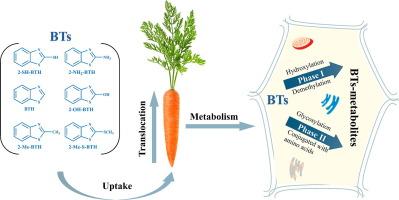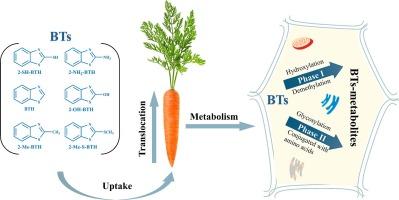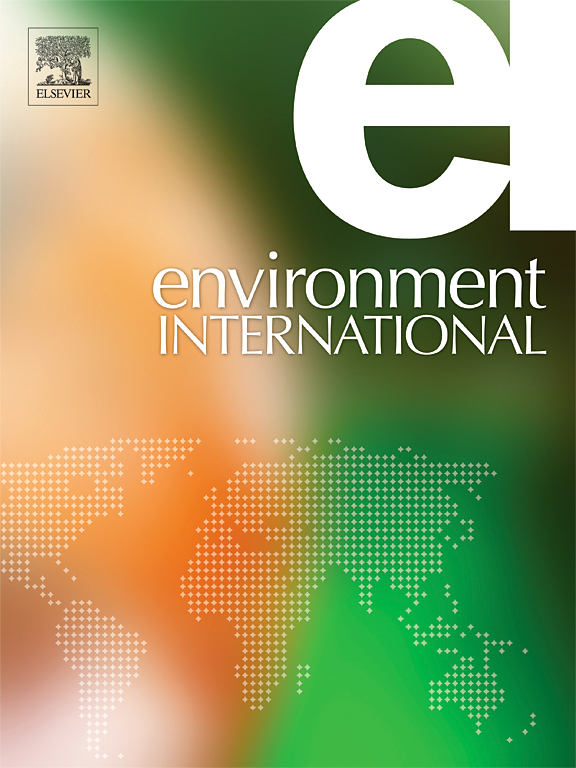胡萝卜对轮胎添加剂苯并噻唑的吸收和代谢与结构有关
IF 9.7
1区 环境科学与生态学
Q1 ENVIRONMENTAL SCIENCES
引用次数: 0
摘要
轮胎添加剂,如苯并噻唑及其衍生物(统称为 BTs),是通过轮胎磨损和其他行为不断排放到农业环境中的大量化学品。BTs 在粮食作物中的潜在积累主要取决于它们在植物体内的新陈代谢,而人们对植物体内的新陈代谢知之甚少。在此,我们评估了六种 BTs 在胡萝卜胼胝体和完整胡萝卜植株中的吸收和代谢情况,以了解其特定结构的代谢。所有 BTs 都很容易被胡萝卜根系吸收,其根系浓缩因子(RCF)从 1.66 ± 0.01 到 2.95 ± 0.05 不等。虽然测试的 BTs 从根部到叶片的向上转移能力较差(转移因子< 1),但 2-甲基苯并噻唑(0.79)和 2-氨基苯并噻唑(0.65)的转移因子明显高于 2-甲基苯并噻唑(0.18)和 2-(甲硫基)苯并噻唑(0.22)。这些结果表明,胡萝卜对 BTs 的吸收和转运与结构有关。辛醇/水分配系数对数与 RCF 或 TF 对数之间的相关分析表明,BTs 的疏水性主要影响其在胡萝卜中的根吸收和向茎转移。借助高分辨质谱法,共初步鉴定出 18 种新的 BT 代谢物,表明 BT 化合物可被胡萝卜胼胝体代谢。所提出的 BTs 代谢产物包括 4 种羟基化产物、1 种去甲基化产物、5 种糖基化产物和 8 种氨基酸共轭产物,表明糖基化和氨基酸共轭是胡萝卜 BT 代谢的主要转化途径。然而,检测到的六种 BT 代谢产物的种类却各不相同,这表明 BT 在植物体内的代谢具有结构特异性。本研究的发现加深了我们对植物中 BTs 的结构依赖性归宿和转化的理解。由于食用作物中的 BTs 代谢物可能成为消费者的意外暴露途径,因此在应对人类膳食暴露风险时,必须考虑 BTs 在植物中吸收、代谢和积累的结构特异性差异。本文章由计算机程序翻译,如有差异,请以英文原文为准。


Structure-Dependent uptake and metabolism of Tire additives Benzothiazoles in carrot plant
Tire additives, such as benzothiazole and its derivatives (collectively called BTs), are large-volume chemicals that are constantly emitted into agricultural environment via tire-road wearing and other actions. The potential accumulation of BTs in food crops depends largely on their metabolism in plants, which is poorly understood. Herein, we evaluated uptake and metabolism of six BTs in carrot callus and intact carrot plants to understand their structure-specific metabolism. All BTs were readily taken up by carrot roots, with their root concentration factors (RCF) ranging from 1.66 ± 0.01 to 2.95 ± 0.05. Although the tested BTs exhibited poor upward translocation from root to leaves (translocation factors < 1), the translocation factors of 2-methylbenzothiazole (0.79) and 2-aminobenzothiazole (0.65) were significantly higher than that of 2-methylbenzothiazole (0.18) and 2-(methylthio)benzothiazole (0.22). These results indicated the structure-dependent uptake and translocation of BTs in carrot. Correlation analysis between log Kow and log RCF or TF revealed that the hydrophobicity of BTs predominantly affected their root uptake and acropetal translocation in carrots. With the aid of high-resolution mass spectrometry, a total of 18 novel metabolites of BTs were tentatively identified, suggesting that BT compounds can be metabolized by carrot callus. The proposed metabolites of BTs include four hydroxylated products, one demethylated product, five glycosylated products and eight amino acid conjugated products, revealing that glycosylation and amino acid conjugation were the dominant transformation pathways for BT metabolism in carrot. However, the detected species of metabolites for six BTs varied distinctly, indicating structure-specific metabolism of BTs in plants. The findings of this study improve our understanding of structure-dependent fate and transformation of BTs in plants. Since BTs metabolites in food crops could present an unintended exposure route to consumers, the structure-specific differences of BTs uptake, metabolism and accumulation in plants must be considered when addressing human dietary exposure risks.
求助全文
通过发布文献求助,成功后即可免费获取论文全文。
去求助
来源期刊

Environment International
环境科学-环境科学
CiteScore
21.90
自引率
3.40%
发文量
734
审稿时长
2.8 months
期刊介绍:
Environmental Health publishes manuscripts focusing on critical aspects of environmental and occupational medicine, including studies in toxicology and epidemiology, to illuminate the human health implications of exposure to environmental hazards. The journal adopts an open-access model and practices open peer review.
It caters to scientists and practitioners across all environmental science domains, directly or indirectly impacting human health and well-being. With a commitment to enhancing the prevention of environmentally-related health risks, Environmental Health serves as a public health journal for the community and scientists engaged in matters of public health significance concerning the environment.
 求助内容:
求助内容: 应助结果提醒方式:
应助结果提醒方式:


